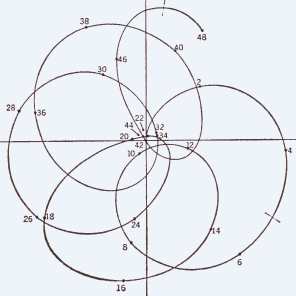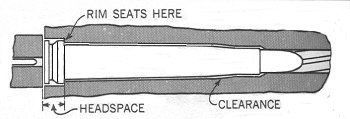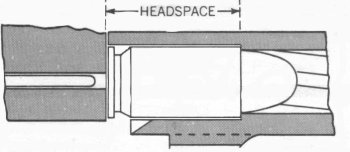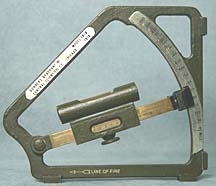
Family
Cookbook
Travel
Guns
Teach
Cartridges
Rifles
Handguns
Shotguns
Shooting Skills
Maintenance
General Information
Links
Miscellaneous Questions #9
Do
bullets tumble in flight?
Just
how damaging to hearing is the sound of gun fire?
How
much adjustment in sizing is obtained when you back out
a reloading
die?
What
is the worlds most accurate rifle?
How
do I get a job in the field of ballistics?
What
is "headspace?"
What
is
meant by "point blank" range?
Q. Do bullets tumble in flight?
A. A properly stabilized bullet (that is, one spun with sufficient rotational speed by the rifling) does not tumble in flight, but may tumble upon impact with a soft target. If a bullet were to actually tumble in flight, its accuracy would be so bad as to be unusable. What does happen is, that due to aerodynamic lift on the bullet and minute inconsistencies in the location of the bullet's center of gravity, that the bullet's point may precess slightly, that is move about the centerline of the bullet's flight, but the bullet remains point forward. This precession is quite small and if the rotational speed of the bullet is optimum the point precession dampens out to a negligible amount in a process known as "going to sleep."
|
|
|
Bullet point precession. From the Frankford
Arsenal drawing. |
Tumbling on impact is a totally different effect and is characteristic of fully jacketed pointed bullets such as the .30-06 M2, 7.62 mm NATO M80, and the 5.56 mm M193/M855 military bullets and many short overall length round nose bullets. This impact tumbling is caused because the bullet's center of gravity is towards its base and when the bullet impacts soft material and its point is slightly deflected the base begins to rotate forward. If the bullet's impact velocity is above about 2700 f/s the bullet may actually fragment due to the forces on it.
As a historical note the original M16 had a 1:14 twist rifling which did not adequately stabilize the M193 bullet in cold weather. Tests showed that when temperatures dropped to about 32 degrees F that the bullet tumbled in flight so badly that shots could not be kept on a 100 yard target. Changing the twist to 1:12 solved this problem. The new 62 gr M855 ammunition needs a twist of 1:9 or faster to adequately stabilize its bullet and when fired from a 1:12 twist barrel the bullet tumbles in flight because it is not stable with that twist rate.
As an aside it is possible to over-stabilize/over- spin a bullet to the point where it comes apart in flight in a puff of "smoke," becoming what some folks call a "blue screamer."
Q. Just how damaging to hearing is the sound of gun fire?
![]()
A.
It is generally accepted that a continuous noise level of 85 db
(decibels) as measured on the "A" scale is the maximum safe
level for long term expose to steady noise level with in the
frequency range of about 600 - 1200 Hz. The very brief
gunfire
noises are another matter.
Leading hearing specialists stipulate that about 150 db is the maximum peak limit for gunfire noises without impairment of speech perception and 140 db maximum without impairment of good hearing of music and the like. The table below will give you an idea of the sound level of some typical firearms, measured at the location of the shooters ears. It should be noted that decibels are a logarithmic scale and that the sound energy doubles with each 3 db increase.
|
Cartridge |
Peak
Noise Level |
|
12 & 20 ga field load shotshells |
173 |
|
.30-06 |
170 |
|
.30-30 |
168 |
|
.458 Win Mag |
175 |
|
7 mm Rem Mag with a muzzle brake |
182 |
|
.243 Win |
170 |
|
.22 LR Rimfire HS |
155 |
|
.22 LR Rimfire Standard velocity |
150 |
|
.22 Short Rimfire Standard velocity |
143 |
|
Sionics Modified .308 Win (circa '75) |
154 (169 unmodified) |
The information above makes it clear that hearing protection should be mandatory when shooting. Most of this data was excerpted from "Acoustic Trauma of Sportsman Hunters Due To Gun Firing," The Laryngoscope, Volume LXXII, No. 11, November 1972
Q. How much adjustment in sizing is obtained when you back out a reloading die?
![]()
A.
Standard reloading dies have a 7/8
-14 body thread. The table below show the effect of
backing the die out the stated amount.
|
Turns |
Distance |
|
1/8 |
.0089" |
|
1/4 |
.0178" |
|
1/2 |
.0357" |
|
1 |
.0714" |
The threads on bullet seating stems seem to vary by manufacturer and there is sometime a difference between dies of the same manufacturer. Use a thread pitch gauge (don't try to estimate it by eyeball) and divide 1 by the threads per inch to get the movement for one full turn of the screw.
Q. What is the worlds most accurate rifle?
![]()
A.
The great Towsend Wheelan once said, "Only accurate
rifles are interesting." While accuracy, in and of itself
is an interesting subject one can get carried away with it.
As
an aspect of, "let's see what can be done" the following
are the world records from the International Benchrest Shooting
Association as of January, 2003. (Note that the 2000 yard
data
is not official.) Keep in mind that some of the firearms used to
obtain these groups push the definition of "firearm" and
are not something you'd carry in the field. Click
here for a further discussion
on how much
accuracy is really needed. Keep in mind that true accuracy
is
not what you did once but what can be done on demand. Also
note
that the number of shots fired has an affect on the group size--so
if
you want a one-hole group the easy thing is to just shoot
once!
Note that group size is effectively measured from the center of
one
bullet hole to the center of another.
|
Range and Rifle Class |
Number of Shots |
Group
Size |
|
100 Yards (Sporter) |
5 |
.041 |
|
100 Yards (Light) |
5 |
.009 |
|
100 Yards (Heavy) |
5 |
.027 |
|
100 Yards (Unlimited) |
10 |
.115 |
|
200 Yards (Sporter) |
5 |
.110 |
|
200 Yards (Light) |
5 |
.099 |
|
200 Yards (Heavy) |
5 |
.108 |
|
200 Yards (Unlimited) |
10 |
.202 |
|
300 Yards (Sporter) |
5 |
.328 |
|
300 Yards (Light) |
5 |
.297 |
|
300 Yards (Heavy) |
5 |
.149 |
|
300 Yards (Unlimited) |
10 |
.536 |
|
600 Yards (Light) |
5 |
.582 |
|
600 Yards (Heavy) |
10 |
1.793 |
|
1000 Yards (Light) |
5 |
1.437 |
|
1000 Yard (Heavy) |
10 |
4.322 |
|
2000 Yard (Assumed to be Heavy)* |
5 |
6.270 |
|
* Not an official or confirmed record. |
||
As an interesting aside, I recently (August, 2004) received some information on some ballistic experimentation being done by "an agency" using esoteric "rifles" and specially selected bullets. The folks involved were routinely getting sub-sub-moa groups at 1000 yards (in the order of less than 1") but because the "rifles" do not meet IBSA rules they can't claim the record.
Update 2018-07-31: On July 21, 2018 a 1.068" 5-shot group (5X) (that's 0.102 MOA) was fired by a Mike Wilson using a "heavy" class rifle, chambered in the 6mmBR Ackley Improved Wilson, and 103g Vapor Trail projectiles, at the Hawks Ridge Gun Club in Ferguson, N.C..
As an example of what can be done with a BIG caliber rifle the current world record at 1000 yards with a .50 BMG chambered "heavy" rifle (weighing under 50 pounds) is 2.6" and with the "light" class (under 32 pounds) .50 cal rifle it is 2.97" both for a 5-shot group.
Q. How do I get a job in the field of ballistics?
![]()
A.
I've been frequently asked this question. As far as I know
there are no college "ballistics" programs. What you
need is a physics background and a good math foundation.
Once
you have that you can aim towards the ballistics field from within
a
job in a related field. The best place to work used to be at
the Ballistics Research Laboratory at Aberdeen Proving Ground but
that has been closed and the research is done elsewhere. If
you
are looking for some up to date reading on the subject try the
following books which were written by various experts in the field
and not gun rag writers. Please note that I cannot help
you
locate these books.
Exterior
Ballistics
Modern
Exterior
Ballistics The Launch and Flight Dynamics of Symmetric
Projectiles, by Robert L. McCoy, $95.00 Hardcover (January
1999)
Schiffer Publishing, Ltd.; ISBN 0764307207 -- The most up to
date
work on the subject Note: If you have or obtain
this book
there were some typos in the text that were not corrected at
printing. The corrections are available in zipped MS
Word
format by clicking
here.
You will need to have the MS Equation Editor installed to
properly
view the document.
Bullet's Flight From Powder to Target--Ballistics of Small Arms, by F. W. Mann, $75, (June 1980) Wolfe Pub Co; ISBN 0935632042 -- Another classic work on early ballistics experimentation.
Understanding Firearm Ballistics Basic to Advanced Ballistics Simplified, Illustrated and Explained, by Robert A. Rinker, $24.95, (January 1999) Mulberry House Pub, ISBN 0964559846
Hatcher's Notebook, by Julian S. Hatcher, 3rd edition, about $30, June 1962, Stackpole Books, ISBN 0811707954 -- A classic work covering many subjects.
The above will pretty much cover the subject. However, the following may be of interest to advanced students. Warning! Most are HEAVY on the math and not light reading.
Aerodynamic
Data
for Spinning Projectiles,
H. P. Hitchcock, BRL Report number 620, October 1947, Ballistic
Research Laboratories, Aberdeen Proving Ground, Maryland, August
1976, [800469] -- Gives a reference for the derivation of
atmospheric
conditions for the standard Army Metro
Aerodynamics
of Bodies of Revolution,
N.F.
Krasnov (Tr. Deane N.Morris), American Elsevier Publishing
Company
Inc. New York 1970. ISBN 0-444-00076-3 Library of Congress Card
Number 73-116707 -- Very math heavy.
An
Alternative Form of the Modified Point-Mass Equation of Motion,
James W. Bradley, Ballistic Research Laboratory, Aberdeen
Proving
Ground, MD, November 1990, BRL-MR-3875.
Body
Alone Aerodynamics of Guided and Unguided Projectiles at
Subsonic,
Transonic and Supersonic Mach Numbers,
Frank G. Moore, Naval Weapons Laboratory, Dahlgren, Virginia,
November 1972, [AD-754 098]
The
Effect of Wind on Flat-Fire Trajectories,
Robert L. McCoy, BRL Report Number 1900, Ballistic Research
Laboratories, Aberdeen Proving Ground, Maryland, August 1976,
[ADB012872] -- Derivation of the wind/time formulas.
Equations
of Motion for a Modified Point Mass Trajectory,
R. F. Lieske, M. L. Reiter, Ballistic Research Laboratory,
Aberdeen
Proving Ground, Maryland, March 1966, Report No. 1314.
Estimation
of the Static Aerodynamic Characteristics of Ordnance
Projectiles at
Supersonic Speeds, Robert
L.
McCoy, Ballistic Research Laboratories, Aberdeen Proving Ground,
Maryland, November 1973, [AD-771 148] -- Covers the modeling the
aerodynamic coefficients of bullets
Exterior
Ballistics of Small Arms Projectiles,
E. D. Lowry, Research Dept., Winchester-Western Division, Olin
Mathieson Chemical Corporation, May 4, 1965. -- Has some useful
formulas and values for various drag functions as a function of
velocity.
Mathematics
for Exterior Ballistics,
Gilbert
Ames Bliss, John Wiley and Sons, Inc., New York, New York, 1944.
--
Explores the derivation of the Siacci methods and the
differential equations of motion.
Methods
for Computing Drag Coefficients from Ballistic Range Data
Using the
APL System, M. Cloutier,
Centre
de Recherches Pour la Defense, Defense Research Establishment,
Valcartier, September 1972, [DRFV-TN-2027/72] -- Presents
methods for
calculating drag coefficients from range data.
Methods
in Exterior Ballistics,
Forest
Ray Moulton, Dover Publications, Inc., New York, New York, 1962.
--
Coverage of rotating projectiles
Interior
Ballistics
Ballistics:
Theory and design of guns and ammunition,
Carlucci, Donald, Sidney Jacobson, CRC Press, Boca Raton, FL,
2008,
ISBN 13:978-1-4200-6618-0 and 10:1-4200-6618-0
Gun
Propulsion Technology,
Edited by Ludwig Stiefel, (Progress in Astronautics And
Aeronautics
Vol. #109, Martin Summerfield: Series editor in chief 1988)
Internal
Ballistics,
ed. Colonel F. R. W. Hunt, Philosophical Library, Inc., 15
East 40th
Street, New York, NY, 1951.
Interior
Ballistics Modeling Applied to Small Arms Systems,
Sidney Goldstein, US Army Armament Research and Development
Command,
Fire Control and Small Caliber Weapon Systems Laboratory,
Dover, NJ,
1979, Technical Report ARSCD-TR-79001 [ADA076175]
Interior
Ballistics of Guns,
ed. Herman Krier and Martin Summerfield, Volume 66, Progress
in
Astronautics and Aeronautics, American Institute of
Aeronautics and
Astronautics, 1979
Theory
of the Interior Ballistics of Guns,
J. Corner, M.A., Ph.D., John Wiley and Sons, Inc., 1950.
The
Thermodynamics of Firearms,
Clark Shove Robinson, McGraw-Hill Book Company, Inc.,
1943
Terminal
Ballistics
Bullet
Penetration - Modeling the Dynamics and the Incapacitation
Resulting
from Wound Trauma,
Duncan MacPherson, Ballistic Publications, El Segundo, CA,
1994,
ISBN: 0964357704
![]()
A.
Put in very
simple
term headspace is basically the distance between the a front
datum
point in the chamber and the face of the breech bolt. With
cartridges having a rim the headspace is measured from the back
face
of the barrel to the face of the breech. With rimless
cases it
is measured from either the mouth of the case (if a straight
walled
case) or from a datum point on the shoulder of the
case.
|
|
|
|
Rimmed cartridge headspace |
Rimless cartridge headspace |
|
|
|
|
Belted cartridge headspace |
Straight walled cartridge headspace |
Headspace is measured using a precision gauge cut to the dimensions required. Headspace gauges generally come in three sizes.
-
Go gauge - The bolt must be able to lock up on this gage. It sets the minimum acceptable headspace.
-
No-Go gauge - The bolt should not be able to lock up on a new barrel or weapon, and partially lock up or lock up only with some effort on a new barrel.
-
Field" gauge - The bolt should not be able to fully lock up or only lock up with effort on a used barrel.
-
Super Field - For some rifles there may also be a "Super Field " or "Field II" gage that the bolt should never even partially lock on. This gage establishes the absolute maximum chamber dimension per the approved chamber drawings.. Colt uses such a gage to reject M16 rifles.
|
|
|
Rimless Cartridge headspace gauge |
Q. What is meant by "point blank" range?
![]()
A.
Point Blank Range refers to the maximum distance at which a given
target can be hit without having to adjust the sights or hold the
sights over or under the target--and thus varies with the accepted
size of the target and the range the firearm is zeroed at.
For
example if we assume a 6" diameter target the point blank range
would be base upon a zero range where the bullet didn't rise
above the line of sight more than 3" and the point blank range
would be the range at which the bullet dropped 3". For
more information see my external ballistics pages by clicking
here.
The name came from the 1500s, when the first artillery as we know it today was in its infancy, an Italian mathematician named Niccolo Tartaglia made some defining inroads into the new science. In 1537 he published a scientific paper on gunnery, and within the next ten years, he had perfected a device known as the Gunner's Quadrant. This mechanism helped calculate the barrel elevation and depression needed to strike a target at a given range.
The Gunner's Quadrant consisted of two wooden arms, joined at a right (90-degree) angle, similar to a carpenter's framing square, Between the arms was an arc (like a protractor) marked off in 12 divisions, known as "points." At the juncture of the two legs, a plumb line hung down and bisected the arc. To use the quadrant, the gunner the long arm down the cannon s barrel, and adjusted the barrel s elevation/depression so that the plumb line intersected the correct "point" his gunners table showed for the distance to the target. When the barrel was nearest the vertical, the plumb line crossed Point Twelve. When the gun barrel was horizontal, the plumb line crossed at Point Zero.
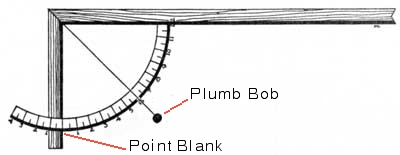
In the 16th Century, most of Europe was still using Roman Numerals, and the concept of "zero" was still pretty radical, as no zero exists in that numeration system. So instead of calling it "Point Zero," since that space on the quadrant was empty (blank), it came to be called/translated to "Point Blank."
A similar device has been used on modern artillery to determine bore angle.
|
|
|
M1918M1 Gunner's Quadrant |
As an aside, Niccolo Tartaglia also proved another radical point of gunnery, by demonstrating that a projectile's ballistic path is always parabolic. Even into the 19th Century, some gunners thought that a cannon ball (or musket ball), fired horizontally, continued to travel in a straight (horizontal) line until it ran out of momentum, and then suddenly dropped. This mistaken concept was often misinterpreted as Point Blank Range, i.e., that flat, horizontal range of a projectile when it was guaranteed to strike the target in sight.
